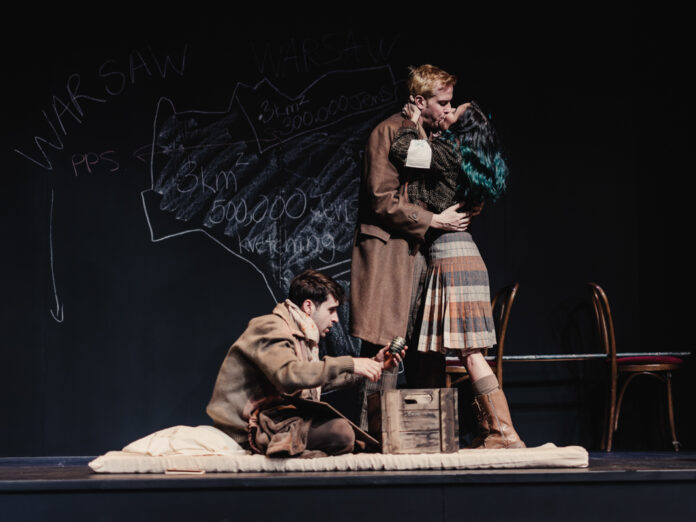
WARNING: This article contains mention of violence and the Holocaust. Those in need of support can contact the Mental Health Crisis Line: 613-722-6914 (within Ottawa) and 1-866-996-0991 (outside Ottawa), the Ottawa Distress Centre Crisis Line: 613-238-3311, or the Youth Services Bureau 24/7 Crisis Line: 613-260-2360 or 1-877-377-7775 (toll).
As the lights dimmed on the Great Canadian Theatre Company (GCTC) stage, viewers were transported back in time to the Warsaw Ghetto in 1943. Forever Young: A Ghetto Story is a humorous depiction of life and love in the darkest of times.
Written by Darrah Teitel and directed by Sarah Kitz, the play follows a group of teenagers, led by their spirited leader Izzy, in their quest to lead an uprising against the oppressive Nazi regime in Poland during the Second World War. As the teens plot and execute their plan, they learn to overcome differences in religion, class and political affiliations as they unite against a common enemy and fight for survival.
Overall, the play was a heartbreaking reminder of the horrors of the Holocaust, and a representation of humanity in its rawest form.
Comedic moments interspersed throughout the play provided lighthearted moments in contrast to the play’s dark subject matter. Cast members effectively balanced the sombre themes with the comedic elements as they delivered key lines with dexterity and confidence.
In the role of Izzy, Ori Black’s performance was stunning, moving and delicate. The lead actor’s stage presence was massive, and the energy he brought to the stage radiated throughout the theatre. Black brought his character to life, using leadership to unite his peers and fellow cast mates onstage.

Billie Nell brought notable nuance to Joshua’s character through the use of vocal intonations, body language and social mannerisms. Nell elevated Joshua to be one of the most unique characters out of the cast, with his pacifist disposition paired with an almost robotic intelligence requiring the highest attention to detail.
Together, Black and Nell brought impeccable dynamics to the relationship between their characters. LGBT+ relationships are not often portrayed in historical fiction, but this play accentuated the importance of intertwining the past with the present to normalize LGBT+ stories within historical contexts.
Portrayed by Brittany Kay and Drew Moore, respectively, Eden and Christian’s relationship dynamic was a highlight of the production as they explored the nuances of love in times of war. Both actors had a powerful chemistry that allowed for moving, humorous and entertaining moments throughout the performance.
Moments where the cast broke the fourth wall and directly addressed the audience to give historical context to the plot were interspersed throughout the play. This aided the audience in their understanding of the events upon which the production was based, and made the severity of the subject matter all the more impactful.
Perhaps one of the most impressive elements of the production were the costumes, designed by Vanessa Imeson. Each character’s outfit blended modern stylistic elements and 1940s attire, complete with unique accents specific to each character. Eden’s blue hair spoke to the rebellious and non-traditional side of her character, and Izzy’s jewelry highlighted his pizazz and intensity.
The technical elements added another level of dimension to the play. Sound designer Olivier Fairfield mastered the use of music to enhance pivotal and emotional moments, while lighting designer Seth Gerry and set designer Brian Smith did an outstanding job of transporting audiences into the ghetto.
The production highlighted the importance of intersectionality when retelling history. In a time when LGBT+ relationships and strong female characters were not at the forefront of historical accounts, the play shed light on the value of these important historical perspectives.
Forever Young: A Ghetto Story is a much-needed reminder that even in the darkest of times, hope prevails. The play draws stark connections to today’s world, where young people are still leading the fight for a more compassionate world.
Forever Young: A Ghetto Story will continue its run at the GCTC until Nov. 20. Tickets are available on the GCTC website.
Featured image by Curtis Perry.





